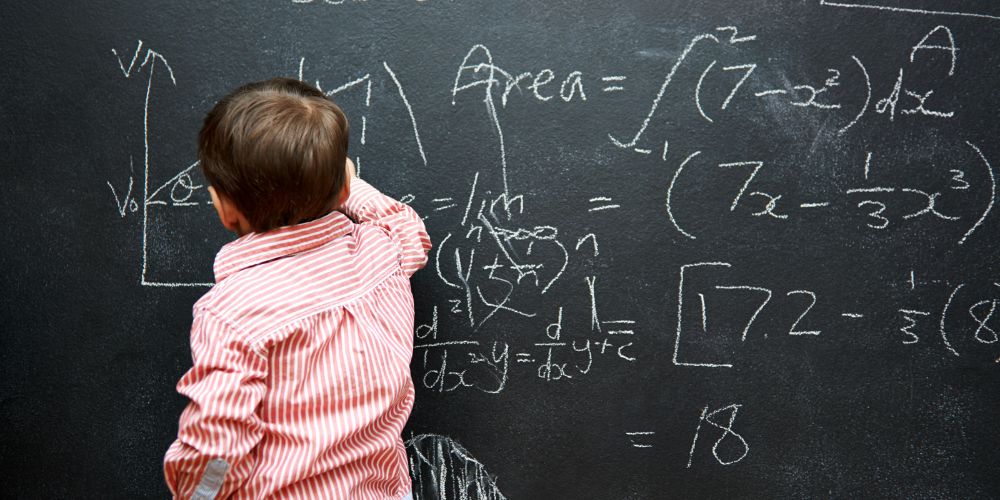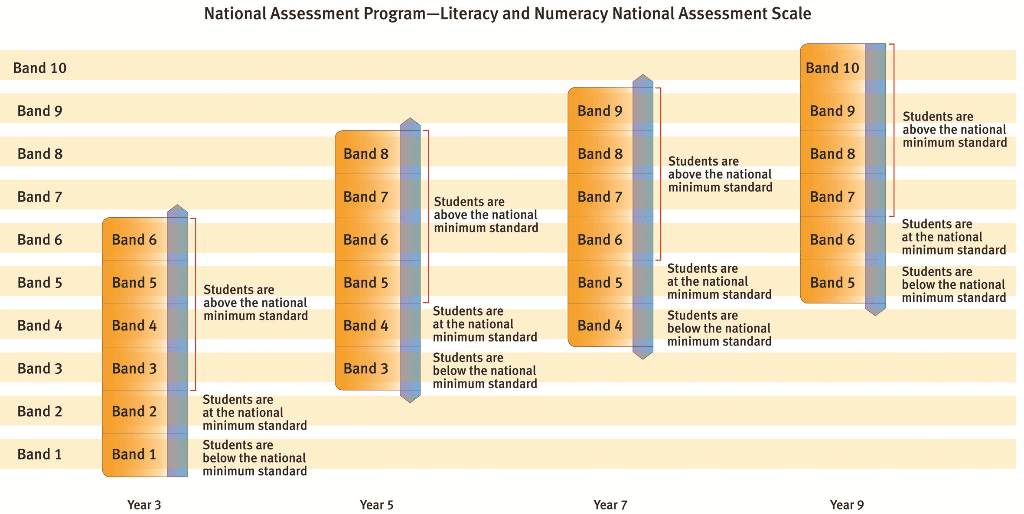NAPLAN assesses a student’s numeracy and literacy skills in Australian schools. What is NAPLAN? And why is it crucial for your child in Years 3,5,7, and 9?
The best guide to NAPLAN &
NAPLAN online
Edulyte answers all your questions and queries about NAPLAN and offers unique ways to make your child NAPLAN ready.

Estimated reading time: 28 minutes
Table of Contents
NAPLAN assesses a student’s numeracy and literacy skills in Australian schools. What is NAPLAN? And why is it crucial for your child in Years 3,5,7, and 9?
Parents, teachers, and students discuss the NAPLAN and prepare for it every year. NAPLAN gives your child the advantage of improving the core skills necessary for a successful career and life. So let us offer you the essential information about this decisive test.
What is NAPLAN?
The NAPLAN website declares that NAPLAN stands for The National Assessment Program-Literacy and Numeracy, an annual national assessment for all students of Year 3, Year 5, Year 7 and Year 9. Students at these school levels have to attempt tests dealing with; numeracy, reading, writing, and language conventions (spelling, grammar and punctuation).
Who conducts the NAPLAN?
The educational organisation ACARA conducts NAPLAN (Australian Curriculum, Assessment, and Reporting Authority). Public and private Australian schools offer it to students in Years 3, 5, 7, and 9.
How many tests are there? And what is the duration of the tests?
NAPLAN is a set of four or five tests. These tests last over three days during Term 2.
NAPLAN for Year 3 and Year 5
As a student of Year 3 or Year 5, your child has to attempt four tests. The tests include
- Language Conventions
- Writing
- Reading
- Numeracy
NAPLAN for Year 7 and Year 9
If your child is in Year 7 or Year 9, the following five tests will be a part of the NAPLAN:
- Language Conventions
- Writing
- Reading
- Numeracy: Calculator Allowed and Non- Calculator
*NAPLAN is being conducted in March from 2023

NAPLAN test duration
Day 1: Language Conventions
- Year 3 and Year 5: 40 mins.
- Year 7 and Year 9: 45 mins.
Writing
- Year 3 and Year 5: 40 mins.
- Year 7 and Year 9: 40 mins.
Day 2: Reading
- Year 3 and Year 5: 45-50 mins.
- Year 7 and Year 9: 65 mins.
Day 3: Numeracy
- Year 3 and Year 5: 45-50 mins.
- Year 7 and Year 9: Calculator: 40 mins.
- Non- Calculator: 40 mins.
What is the purpose of NAPLAN?
As parents and students, we need to know the purpose of such an evaluation. To put it simply, NAPLAN decides if the students are attaining the requisite literacy and numeracy goals.
Teachers can measure their students’ academic level against the national yardstick. They can recognise the strengths and weaknesses of the educational program and their students.
Parents get a detailed insight into their children’s progress over the years. In addition, these tests give a fair idea about their children’s mathematical, reading, and writing abilities.
These tests help determine if the educational programs are successful and point out aspects of the programs that have to be modified or changed. Schools get comprehensive details about the students’ performance in critical subjects over time. Strategising becomes easier to enable students to reach their full potential with the NAPLAN evaluation.
NAPLAN is online
With the federal, states and territories governments pushing for it, NAPLAN is transitioning towards a computer-based evaluation. Being such a test gives it more accuracy. The students are better engaged during the online test, and also, the results are more precise. More details are available on nap.edu.au
What are the various aspects of NAPLAN?
NAPLAN tests the learning areas of Reading, Writing, Language Conventions and Numeracy.
The criteria and standards for each domain is listed below for each Year:
Reading
The NAPLAN reading test is in tune with the English curriculum of Australia across the states and territories. Students get a magazine containing a range of texts with different writing styles. Students read the texts provided and answer related questions in a separate booklet.
The range and complexity of texts increase with each Year.
Year 3
When reading simple, imaginative texts, students can:
- find directly stated information
- connect ideas across sentences and paragraphs
- interpret ideas, including some expressed in complex sentences
- identify a sequence of events
- infer the writer’s feelings.
When reading simple information texts, students can:
- find directly stated information
- connect an illustration with ideas in the text
- locate a detail in the text
- identify the meaning of a word in context
- connect ideas within a sentence and across the text
- identify the purpose of the text
- identify conventions such as lists and those conventions used in a letter.
Year 5
When reading a short narrative, students can:
- locate directly stated information
- connect and interpret ideas
- recognise the relationship between text and illustrations
- interpret the nature, behaviour and motivation of characters
- identify cause and effect.
When reading an information text, students can:
- locate directly stated information
- connect ideas to identify cause and effect
- identify the main purpose for the inclusion of specific information, diagrams and illustrations
- identify the meaning of a phrase in context
- infer the main idea of a paragraph.
When reading a biography or autobiography, students can:
- connect ideas
- identify the main purpose of the text
- make inferences about the impact of an event on the narrator
- interpret an idiomatic phrase or the meaning of a simple figurative expression.
When reading a persuasive text such as an advertisement, students can:
- locate directly stated information
- identify the main idea of a paragraph or the main message of the text.
Year 7:
When reading a narrative, students can:
- infer the motivation or intention of the narrator or a character
- draw together ideas to identify a character’s attitude
- interpret dialogue to describe a character
- connect ideas to infer a character’s intention or misconception, or the significance of the character’s actions
- interpret the significance of an event for the main character.
When reading a poem, students can:
- identify the intention of the narrator.
When reading an information text, students can:
- identify the main idea of a paragraph and the main purpose of the text
- link and interpret information across the text
- recognise the most likely opinion of a person
- use text conventions to locate a detail.
When reading a persuasive text such as an argument, students can:
- locate and interpret directly stated information, including the meaning of specific words and expressions
- identify the main message of the text
- identify the purpose of parts of the text
- interpret the main idea of a paragraph
- infer the writer’s point of view
- identify points of agreement in arguments that present different views
- identify and interpret language conventions used in the text, such as lists, order of online posts and the use of punctuation for effect
- identify the common theme in a variety of writers’ opinions.
Year 9:
When reading a complex narrative, students can:
- locate a directly stated detail
- connect ideas across a paragraph or across the text to interpret a description of the motivation of characters
- infer the main idea
- interpret and evaluate a character’s behaviour and attitude
- interpret dialogue to describe a character
- interpret the reasons for a character’s response
- connect ideas to interpret figurative language
- interpret the effect of a short sentence.
When reading a poem, students can:
- identify the main idea of the poem.
When reading a complex biographical text, students can:
- locate a directly stated idea in the text.
When reading a complex informational text, students can:
- locate directly stated information
- connect ideas in the introduction of the text or in the body of the text and illustrations
- identify the main purpose of a text or an element of the text
- identify the main idea of a paragraph
- identify the purpose of a labelled diagram
- identify the intended audience of the text
- identify conventions used in a text, such as abbreviations or italics for a foreign word.
When reading a persuasive text such as an argument, students can:
- connect ideas across the text or in two arguments
- identify the tone of an argument

Writing
The Australian English Curriculum expects students to be confident in writing three types of texts. They are:
- imaginative writing (including narrative writing)
- informative writing
- persuasive writing
Students are provided with a prompt or an idea in the writing tests and asked to write a response in a particular text type. Students are given two writing prompts one prompt for Years 3 and 5; and a different prompt of the same text type for Years 7 and 9.
Persuasive writing
Marking criterion description of persuasive writing marking criterion Audience.
| Criteria | Score Range | Description |
| Audience | 0-6 | The accuracy of spelling and the difficulty of the words used |
| Text Structure | 0-4 | The organisation of the structural components of a persuasive text (introduction, body and conclusion) into an appropriate and effective text structure |
| Ideas | 0-5 | The selection, relevance and elaboration of ideas for a persuasive argument |
| Persuasive Devices | 0-4 | The use of a range of persuasive devices to enhance the writer’s position and persuade the reader |
| Vocabulary | 0-5 | The range and precision of contextually appropriate language choices |
| Cohesion | 0-4 | The control of multiple threads and relationships across the text, achieved through the use of referring words, ellipsis, text connectives, substitutions and word associations |
| Paragraphing | 0-3 | The segmenting of text into paragraphs that assists the reader to follow the line of argument |
| Sentence Structure | 0-6 | The production of grammatically correct, structurally sound and meaningful sentences |
| Punctuation | 0-5 | The use of correct and appropriate punctuation to aid the reading of the text |
| Spelling | 0-6 | The accuracy of spelling and the difficulty of the words used |
Narrative writing
Marking criteria description of narrative writing marking criteria:
| Criteria | Score Range | Description |
| Audience | 0-6 | The writer’s capacity to orient, engage and affect the reader |
| Text Structure | 0-4 | The organisation of narrative features including orientation, complication and resolution into an appropriate and effective text structure |
| Ideas | 0-5 | The creation, selection and crafting of ideas for a narrative |
| Character And Setting | 0-4 | Character: the portrayal and development of character Setting: the development of a sense of place, time and atmosphere |
| Vocabulary | 0-5 | The range and precision of language choices |
| Cohesion | 0-4 | The control of multiple threads and relationships over the whole text, achieved through the use of referring words, substitutions, word associations and text connectives |
| Paragraphs | 0-2 | The segmenting of text into paragraphs that assists the reader to negotiate the narrative |
| Sentence Structure | 0-6 | The production of grammatically correct, structurally sound and meaningful sentences |
| Punctuation | 0-5 | he use of correct and appropriate punctuation to aid reading of the text |
| Spelling | 0-6 | The accuracy of spelling and the difficulty of the words used |

Language conventions
Language conventions are essential for reading and writing English. Australian English grammar, spelling and language form the core of this test. Multiple choice or fill-in-the-blank questions are usually part of the language conventions evaluation.
The minimum standards expected of a student of each level are given below:
Spelling
The Year wise criteria for Spellings is as follows:
Year 3
Students can correct identified errors in:
- frequently-used one-syllable words
- frequently-used two-syllable words with regular spelling patterns.
Year 5
Students can correct identified errors in:
- frequently-used one-syllable long vowel words
- frequently-used one-syllable words with irregular spelling patterns
- common one-syllable verbs with tense markers
- high-frequency two-syllable words.
Students can identify and correct errors in:
- frequently-used one-syllable words
- high-frequency compound words
- less regularly used multi-syllable words with double letters.
Year 7
Students can correct identified errors in:
- less frequently used one-syllable words
- less frequently used compound words with regular spelling patterns
- two-syllable words with irregular spelling patterns
- less frequently used multi-syllable adverbs.
Students can identify and correct errors in:
- one-syllable ‘soft c’ words
- one-syllable words ending with silent letters
- one-syllable words with irregular spelling patterns
- frequently-used compound words with irregular spelling patterns.
Year 9
Students can correct identified errors in:
- less frequently used one-syllable words with double or r-controlled vowels
- less frequently used two-syllable words
- multi-syllable words with the suffix ‘ance’.
Students can identify and correct errors in:
- multi-syllable soft ‘c’ words
- multi-syllable words with regular spelling patterns.
Minimum standards for grammar and punctuation
The standards that each student has to meet for grammar and punctuation Year-wise are given below.
Year 3
In grammar, students can:
- identify the correct preposition required to complete a sentence
- identify the correct pronoun required to complete a sentence
- identify the correct adverb of time required to complete a sentence
- identify the correct form of a participle required to complete a sentence.
In punctuation, students can:
- identify the correct location of a full stop
- identify proper nouns that require capitalisation.
Year 5
In grammar, students can:
- identify the correct conjunction required to join a pair of simple sentences
- identify the correct form of the verb required to complete a sentence
- identify which adverb in a sentence describes how an action took place
- identify the correct plural pronoun required to complete a sentence.
In punctuation, students can:
- identify direct speech that uses capital letters, question marks and speech marks.
Year 7
In grammar, students can:
- identify the correct form of the verb required to complete a complex sentence
- identify the correct personal pronoun required to complete a sentence
- identify a correct subject-verb agreement in a sentence
- identify the phrase required to complete a sentence.
In punctuation, students can:
- locate a comma to separate items in a list.
Year 9
In gramma,r students can:
- identify the tense of a short passage
- identify the correct form of a comparative adjective in a sentence
- identify the word that functions as a verb in a sentence.
In punctuation, students can:
- identify the purpose of italics in a sentence
- locate commas in a sentence to emphasise a clause
- recognise that colons can be used to introduce lists.

Numeracy
Mathematics is critical for the development of a successful career. Students have to answer multiple-choice, short answer and fill-in-the-blank questions. NAPLAN numeracy test evaluates the three fields of this subject:
- numbers and algebra
- measurement and geometry
- statistics and probability
Year 3: Number
For Year 3, the students are to know the subject, as mentioned below:
Whole numbers
students can generally:
- recognise three-digit numbers in words and symbols
- recognise odd and even numbers
- make given numbers larger or smaller by 1, by 10 or by 100
- count forwards and backwards by 1s, 2s, 5s and 10s
- skip count by 2s, 5s and 10s.
- compare and order two-digit numbers
- partition one- and two-digit numbers in different ways
- recognise different standard representations of numbers in hundreds, tens and ones.
Fractions and decimals
Students should be able to:
- recognise a half and find half of discrete quantities or amounts
- find half of a symmetrical object
- interpret key decimals in money contexts as dollars and cents.
Calculating
Students can handle the aspects mentioned:
- recall and use addition and subtraction facts to 20
- use partitioning to assist addition and subtraction of one- and two-digit numbers
- interpret repeated addition as multiplication
- form equal groups of objects, given a visual support
- count and record the total value of coins in dollars and cents (up to $5).
Applying number
Students can:
- use addition or subtraction to solve routine problems
- start to link the correct mathematical terms to the relevant operations (e.g. sum, difference, equal groups or equal sharing)
- recognise situations involving a single operation.

Year 3: Space
Classification and properties of shapes
Students can typically recognise and describe familiar 2D shapes and common 3D objects and:
- identify familiar 2D shapes such as squares, rectangles, triangles and circles
- identify families of common 3D objects such as prisms, cones, cylinders
- recognise models and 2D diagrams of common 3D objects
- differentiate between 2D shapes and 3D objects
- recognise angles in shapes, objects and in turns
- visualise simple objects made of cubes.
Transformations
Students are expected to recognise simple transformations of familiar shapes:
- use folding or other techniques to identify a line of symmetry
- recognise the effect of a single flip, slide or turn
- use symmetry or transformations to continue patterns.
Location and movement
students are to:
- identify the key features of simple, informal maps, grids and plans
- use alpha-numeric coordinates to locate the position on simple grids
- interpret informal maps or grids of familiar environments
- follow directions for moving from one point to another using the language of turns.
Year 3: Algebra, function and pattern
Equivalence
In this file of the subject, students have to:
- recognise a familiar correspondence between two sets of objects
- order objects according to a common criterion
- follow a short sequence of instructions
- recognise an equivalent form of a number or a simple expression
- identify the same attribute in measurement or spatial contexts.
Patterns
Students identify and continue patterns and sequences that increase, decrease and repeat.
- recognise and continue a number pattern with a constant addition or subtraction of a small whole number
- identify the change between consecutive terms in a simple pattern.
Year 3: Measurement, chance and data
Measures
Regarding this, students are expected to:
- understand the language used to describe length in familiar contexts
- measure length using informal units
- compare and order objects according to a specific attribute – length, capacity or area.
- decide whether containers hold less, about the same or more than a litre
- use informal units to estimate the length, volume and mass of familiar objects
- use some relationships between standard units, e.g. 1h = 60 min, 1m = 100 cm
- read whole-number scales with all calibrations shown.
- read half and quarter-hour times on analogue clocks
- read the time on digital clocks in hours and minutes
- recognise the time half an hour before or after a given time.
Data
Students are to:
- read and interpret data presented in lists, tallies, tables, pictographs (1:1 or 1:2 correspondence) or simple column graphs and two-way tables
- make qualitative judgements about data in frequency tables
- identify variation of data in tables and graphs.
Year 3: Working mathematically
Students should be able to:
- recall names of familiar shapes, symbols and notations
- recognise images of familiar 2D shapes and 3D objects, and equivalent forms of whole numbers and simple number sentences
- calculate with small numbers and coins
- retrieve information from simple tables, graphs and pictographs
- group shapes, objects or numbers according to a common attribute or property
- compare shapes and objects by lengths, areas and masses.
Students’ ability to apply known problem-solving strategies and procedures to solve routine problems is essential for their progress and their cognitive development. For example, students can generally:
- select the correct operation or a number sentence for a given situation
- compare the information presented in familiar forms
- interpret simple diagrams and tables
- construct number sentences by using known facts
- follow simple instructions
- solve routine problems involving one or two steps

Year 5 : Number
Whole numbers
- recognise different representations of a whole number
- use place value to compare, order or locate numbers on a number line
- multiply or divide by 10 or 100 in place-value contexts.
Fractions and decimals
- identify and use equal partitions, and name the parts
- recognise different representations of simple fractions
- compare decimals with the same number of decimal places
- use common unit fractions to solve routine problems.
Calculating
- recall addition and subtraction facts of small numbers
- identify and use known number facts to assist calculations
- multiply small whole numbers
- complete operations with coins and record amounts of money in decimals
- add or subtract common fractions with the same denominators.
Applying number
- recognise the use of a single operation in familiar contexts
- use addition or subtraction to solve routine problems
- solve routine problems involving a single operation
- add or subtract decimals in money/measurement contexts
- estimate the value of simple computations
- link the four operations to routine situations.
Year 5 : Space
Classification and properties of shapes
- identify features of common shapes and objects
- summarise features of groups of common shapes or objects
- interpret the spatial language used in describing common shapes and objects.
- interpret drawings of shapes or objects that reflect the size and significant features
- recognise different orientations of a shape or different perspectives of an object
- identify shapes or objects with given features
- visualise simple objects made of unit cubes.
Transformations
- identify symmetrical shapes and designs
- identify the result of a single transformation of a simple shape
- identify common shapes that tessellate.
Location and movement
- interpret the symbols for the key compass directions
- link the four major compass points to a quarter, half, three-quarters and a full turn
- interpret and follow directions.

Year 5 : Algebra, function and pattern
Relationships
- identify a familiar criterion used in arranging and sorting shapes or objects
- recognise and describe simple relationships
- use simple tables or graphs to predict change.
- make links between routine multiplication and division facts
- use known facts to work out related calculations
- make changes to computations that maintain equivalence.
Equivalence
- recognise the number sentence that matches a familiar situation
- recognise equivalence in familiar contexts (e.g. balance scales)
- solve one-step number sentences involving simple calculations.
Patterns
Students recognise and describe numerical and spatial patterns. For example, students can generally:
- recognise different representations of the same pattern
- recognise a single relationship between consecutive terms
- continue number patterns requiring one-step calculations.
Year 5 : Measurement, chance and data
Measures
- choose the appropriate attribute to compare objects
- measure and compare areas of shapes on grids, counting whole and half units
- measure and compare volumes by counting informal units
- arrange measurements in order of magnitude
- make reasonable estimates of a quantity using known measures.
- read measures from simple whole-unit scales.
- recognise key times on analogue clocks and read times on digital clocks
- identify equivalent forms of saying and recording a key time
- use calendars and timetables to seek specific information.
Data
- make predictions based on data.
- read tabular and graphical displays involving simple whole-number scales
- check statements or predictions against data
- identify variation within a set of data.
Year 5 :Working mathematically
- recall properties of numbers, common fractions, measures, familiar shapes and objects
- recognise diagrams of common shapes and objects, equivalent forms of whole numbers, common fractions, decimals and simple expressions
- calculate with whole numbers, common fractions with the same denominators and decimals
- read and interpret information from whole-number scales, tables, simple graphs and pictographs (one-to-one or one-to-two correspondence)
- measure length, area, mass and capacity using standard units
- group shapes, objects or numbers according to a familiar attribute.
- select the correct operation or the missing number in a number sentence
- construct and complete a number of sentences involving one operation
- interpret a situation presented in diagrams, tables or simple graphs
- follow simple instructions and procedures
- analyse patterns to identify the rule
- solve routine problems in familiar contexts.

Year 7 : Number
Rational numbers
- order and locate integers, mixed numbers or common fractions on a suitably scaled number line
- recall decimal equivalence of common fractions
- recognise different representations of a common fraction.
Calculating
- solve simple problems in familiar contexts involving addition or subtraction of integers
- use knowledge of place value to multiply and divide decimals by 10 and 100
- perform calculations involving key percentages or addition and subtraction of decimal numbers with the same number of decimal places.
Applying number
- round seven-digit numbers to the nearest thousand
- solve simple rate problems involving time and distance
- select an appropriate approximation to a calculation involving money
- interpret and solve practical problems involving division with access to a calculator.
Year 7 : Space
Classification and properties of shapes
- identify common 2D shapes that have specific properties.
Transformations
- identify an increase or a decrease of a shape or object
- identify lines of symmetry in regular and irregular shapes
- visualise possible results of joining objects made from cubes.
Location and movement
- locate and describe positions on maps or plans using the major compass points
- interpret whole-number scales to estimate the real distance between objects
- follow directions on informal and formal maps using compass points (including NE NW SE SW).
Year 7 : Algebra, function and pattern
Relationships
- recognise and extend a linear relationship in a practical context
- construct and interpret tables and graphs of simple functions
- use the links between the four operations in familiar contexts.
Equivalence
- find the smallest number which satisfies a simple-worded problem in a familiar context
- create and solve number sentences with access to a calculator.
Patterns
- find the next term in a simple non-linear pattern presented visually or in a table, or as a sequence
- recognise and extend simple number patterns to make predictions or to find subsequent terms.
Year : 7 Measurement, chance and data
Measures
- read the time on analogue and digital clocks using 12- and 24-hour time.
Chance and data
- link different representations of the same data
- read and interpret data in a two-way table.
Year 7 : Working mathematically
- recall properties of whole numbers, fractions, decimals and common 2D shapes
- recognise equivalent forms of common fractions and number sentences
- calculate with whole numbers, decimals and key percentages using written methods
- read and interpret information from tables, lists, pictographs and a range of graphs
- group shapes, objects or numbers according to common property.
- select the correct set of operations or relationships for a given situation
- represent situations using tables, graphs, informal number sentences, etc.
- construct number sentences involving at least two operations for a situation
- follow a sequence of mathematics operations, instructions and procedures
- recognise and extend number patterns
- solve routine problems involving the four operations, with or without access to a calculator.

Year 9 : Number
Rational and irrational numbers
- identify a rational expression with the same value as a given fraction
- identify the range within which the square root of a three-digit number lies
- identify the rational number that is a solution to a routine word problem with access to a calculator
- compare and order rational and irrational numbers with access to a calculator.
Calculating
- solve a problem involving addition and subtraction of decimal numbers with different numbers of decimal places
- use simple ratios in familiar practical situations
- identify solutions to multi-step word problems involving common fractions or key percentages.
Applying number
- solve a word problem involving fractions
- solve routine problems involving simple ratios.
- form estimates and approximations of rational and irrational numbers and simple expressions
- interpret and justify the reasons for making estimates and approximations.
Year 9 : Space
Classification and properties of shapes
- visualise nets of prisms or pyramids
- identify the net of a cube using criteria about opposite faces
- interpret 2D representations of 3D objects made from cubes and calculate their surface area.
Transformations
- identify points and lines of symmetry in complex 2D shapes and specify these in terms of reflection, the centre of rotation and angle of rotation
- identify lines and planes of symmetry of common 2D shapes and 3D objects
- use and modify congruent shapes to produce tessellations.
Location and movement
- use alpha-numeric coordinates to specify locations on maps
- identify and use whole-number scales
- follow instructions for moving from one location to another, with reference to distances, directions and angles.
Year 9 : Algebra, function and pattern
Relationships
- identify the linear rule that generates a specific pattern
- identify the graph of a simple non-linear function given a table of values
- read and interpret a range of graphs.
Equivalence
- evaluate simple algebraic expressions with one variable
- identify solutions of simple formal and informal linear equations, unknown on one side only.
- identify equivalent forms of simple algebraic expressions.
Patterns
- identify and continue a number pattern from a given diagram or a table of values
- identify future terms in the visual representation of linear patterns.
Year 9 : Measurement, chance and data
Measures
- find the value of the missing angle in a triangle with access to a calculator.
Chance
- identify probability (expressed as a fraction) of a familiar random event.
Data
- calculate the average (mean) of a set of data
- interpret data presented in a simple bivariate graph
- interpret variation between sets of data and the effects of variation.
Year 9 : Working mathematically
- recall key concepts, properties of numbers and figures and symbolic or specific notations (e.g. a × b = ab, a + a + a = 3a)
- interpret diagrams showing features of 2D shapes and 3D objects
- calculate with whole numbers, fractions, decimals and integers using the four operations and approximate numbers to estimate computations
- carry out routine algebraic procedures
- read and interpret graphs, tables or other sources, read and use simple whole-number scales
- measure lengths, areas, volumes, masses, time, surface areas of basic shapes and objects
- group or order numbers or objects by a given attribute or property.
- choose an appropriate set of operations or a strategy for solving routine problems
- represent and interpret data in familiar tabular and graphical forms
- model a familiar situation with a diagram or an equation
- draw or identify common figures and shapes, given specifications
- solve routine problems
What are the NAPLAN Bands?
If you are unsure how NAPLAN declares the results of the NAPLAN bands, you needn’t fret.

A simplified way to understand the NAPLAN assessment.
- NAPLAN results are shown on a scale for each of the areas tested. The scales are divided into ten bands.
- The scales cover all the Years.
- There is a minimum band for each Year. Band 2 is the minimum standard for Year 3; band 4 is the minimum standard for Year 5; band 5 is the minimum standard for Year 7, and band 6 is the minimum standard for Year 9.
The results are shown with
- a national average
- the range of middle 60 per cent of students
- the national minimum standard and
- your child’s performance regarding all these
Each assessment scale portrays student achievement development in a domain from Year 3 through to Year 9, along a ten-band scale. Such detailed information about students’ performance helps all those involved: the teachers, the parents and the students. The best way to understand the test is to review NAPLAN past papers.
Studying for NAPLAN
Parents and students keep devising strategies on a war footing for a great score in NAPLAN. However, there is much debate about ‘the right method’ to prepare for it.
We at Edulyte get requests and queries about this, so we decided to share our thoughts and expertise.
As parents, you should not forget the focus of this assessment: examining the core skills your child requires to navigate through academics and later life.
Still, the child can find dealing with calculations, multiple-choice questions, creating written passages, and interpreting the questions in a limited time quite overwhelming.
Since we understand the necessity of able guidance and a healthy environment for preparation, we have tailor-made courses and classes for the different Years. Each one of them deals with an individual’s learning curves and requirements. In addition, practical tests, remedial measures and techniques are taught to make the students confident and ready for their NAPLAN tests.
Frequently Asked Questions
NAPLAN, the National Assessment Program — Literacy and Numeracy, is a standardised test conducted in all Australian schools in Years 3,5,7 and 9. It was introduced in 2008 by then education minister Julia Gillard.
NAPLAN is not a ‘pass-fail’ test. Instead, it gives a band scale and a point of comparison which highlights a student’s position and progress regarding core skills.
NAPLAN aligns with the Australian curriculum, and this standardised test is conducted in Australia.
NAPLAN costs $45 per student to administer. Therefore, the annual cost of running NAPLAN crosses more than $100m. The body responsible for developing and administering NAPLAN is the Australian Curriculum and Reporting Authority (ACARA), funded by the Australian government and the Australian states and territories.
To attempt or not to attempt……
As a parent or a student, you might have a query about whether it is compulsory to attempt the NAPLAN assessment. The NAPLAN website states, u0022All students in Years 3, 5, 7 and 9 are expected to participate in NAPLAN tests, and schools should not exert influence on parents or carers to withdraw their child from the tests. NAPLAN tests give you information on how your child progresses against national standards.u0022
Students and parents are discouraged from withdrawing from the tests as it measures the child’s progress in the formative school years.
NAPLAN has scales, and each scale is divided into ten bands used to report student progress through Years 3, 5, 7 and 9. Band 1 is the lowest, and band 10 is the highest. A band contains a range of scores and is not a specific point.
NAPLAN (the National Assessment Literacy and Numeracy test) gives a clear picture of a student’s crucial literary and numeracy skills development. And what is even more significant is that it evaluates the core skills during school years.
A pertinent question and a worry for every parent! NAPLAN is based on the Australian curriculum. So ensure that your child understands the concepts that are taught in school. Practice tests are available to provide a good prep.
Another way to ensure a great score in NAPLAN is by enrolling your child on Edulyte’s classes and courses. We customise our lessons to make your child feel confident regarding the core skills. Click here to know more!
For NAPLAN essential dates, click on: NAPLAN dates
Yes. Australia’s federal states and territories governments have decided to move to a computer-based NAPLAN. NAPLAN online aims to be a tailored assessment. This means it will present questions based on a student’s responses.
In the reading, numeracy and conventions of language tests, questions may be multiple choice or technology-enhanced (such as drag and drop) or require a short written response. In the writing test, students are expected to write a text-based on their understanding g of the writing task.

Who needs a tutor?
Related Blogs & guides
Teaching tips, career guides, resources and much more!
Strategies for Paraphrasing and Summarizing in Thesis Writing
Estimated reading time: 5 minutes Crafting an effective thesis is a daunting task. You have to walk through a tedious process, from performing research and…
Exploring Extracurricular Activities at the International Schools
Estimated reading time: 4 minutes Author: Bangkok Prep The essence of education lies not just in the outreach of knowledge but also in the holistic development…
Format of how to write a letter : Get valuable tips and samples for letter writing
Looking for the proper format of how to write a letter? Get tips on writing formal and informal letters….




